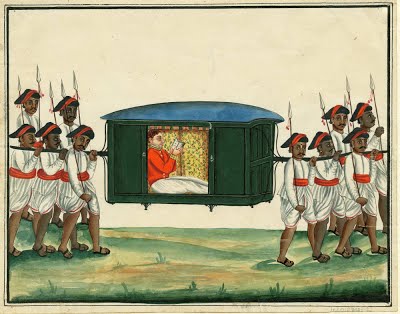The secret language of Palanquin bearers (long thread, 🙏)
A Palanquin is a covered wheel-less carriage (litter) carried on two horizontal poles by men.The word "Palanquin" is from Portuguese palanquin, from Malay or Javanese pelangki, of Indo-Aryan origin; ...
6
58
198
Replies
From Odia pālaṅki, (related to pālkī पालकी) based on Sanskrit पर्यङ्क paryaṅka (= bed, couch). Some other names of palanquin are śivikā शिविका, vāhya वाह्य etc.
2
0
14
The tradition of wheel-less carriages for travelling short & long distances is very old in Indian subcontinent & its use was often restricted to royals, nobles & wealthy. The people who carried these palanquins were variously known as Kahār कहार, Gond गोंड, or Bhoi भोई in...
4
0
12
Travelling by European style Indian palanquins would usually require services of 8 bearers, a mashālcī (torch bearer), & a porter. These palanquin bearers were usually hired by the Palanquin user for the entire journey or on semi-permanent basis, notwithstanding the distance.
1
0
13
Because travelling long distances with the same set of bearers demanded longer time, more rest & provisions, in 1778 East India company under Captain John Harvey started the first "Relay Palanquin Service" between Calcutta & Benaras.
1
0
13
A set of 8 bearers, 2 torch bearers, & a porter were kept ready on the interval of 10 miles, with a sardār (leader) entrusted to supervise them. In 1783, the contract to operate this relay service was later handed over to Post Office Department, giving it the name ḍāk service.
1
0
18
Under this contract, the relay had to cover approx 96 miles per day. Since travelling at this speed over long distances required good navigation & excellent communication between Palanquin bearers, they developed an argot in their languages to communicate effectively...
1
0
15
about the dynamic geography of the path, where to sprint, where to slow, change of shoulders, stopping & starting etc. It became rather important to do this, given bearers at the back side had no clue of what's coming ahead!
2
0
15
Some of the expressions were -
Rāj dariddar rase rase राज दरिद्दर रसे रसे= path is narrow, go slow
Santo, chūṭal māyā संतो छूटल माया= path strewn with sharp stubble
Boltā hau बोलता हौ = there are people on the way
Bhar Kadam भर कदम= take a full step (while crossing an obstacle)
1
0
20
Caltā hau चलता हौ= ground is slippery
Chahāṭā hau छहाटा हौ = ground is muddy
Gaūdān गऊदान= there's cattle on the path
Bail ke kamāi hau बैल के कमाई हौ = a ploughed field ahead. Etc
2
0
14
Interestingly, There were 6 main types of palanquins used across Indian subcontinent.
ḍolī डोली = a litter for women (especially brides)
muḥāfah मुहाफह = curtained litter for women
pālkī पालकी = a litter for men
nālkī नालकी = a kind of open litter (used by bridegrooms)
3
0
15
miyānā मियाना = a mid sized litter with upper cover
Another one was known as tāmjān तामजान, which was an exquisite open palanquin. No wonder Hindi / Urdu for an elaborate although unnecessary arrangement is still known as tāmjhām तामझाम.
3
0
25
If you are a fan of secret languages and codes, here is one thread on
"The Secret Language of Boatman of Prayag (Allahabad), India
1
0
12
1
1
9
3
1
9
@avtansa
A thread that may interest
@LauChircopReyes
who wrote recently on late imperial China martial escorts 鏢客 secret language
0
0
3













